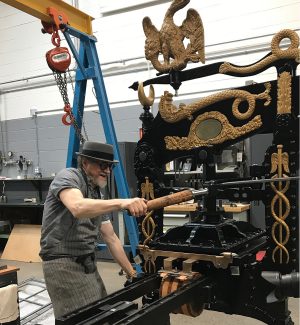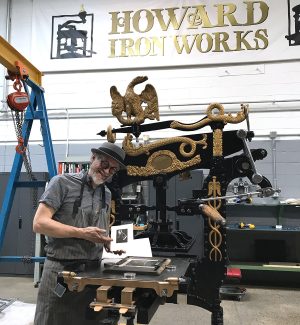Over this past Summer experts at the Howard Iron Works Printing Museum and Restoration, located in Oakville Ontario, carried out delicate repairs while respecting to the utmost, the historical relevance of McGill’s Columbian printing press. Our press had parts missing or unattached such as the back brace and the supports that hold the paper in place for printing. During the repair process, Nick Howard remarked that McGill’s Columbian was the best he had ever seen in the shop, bearing very little trace of past wear and tear. It is now refitted with new cowhide leather belts under the carriage of the bed; the tympan and frisket are re-attached and are a mix between original and new machine parts; and the original iron and bronze castings are polished up. Award-winning woodcut book artist George Walker pulled some proofs of a work in progress on our Columbian while it was the shop.
McGill’s Columbian is the earliest of just 21 surviving presses in North America and only one of 32 in the world of the series designed and manufactured by George Clymer from 1817 to 1830. [1] This press was invented by the American engineer George Clymer (1754?-1834) of Philadelphia in 1813, who had been experimenting with ways to improve the wood common press from about 1800 before he settled on his design in iron integrating a complex system of levers. The Columbian is a second improvement over the invention of the first iron press by the Earl of Stanhope. Clymer manufactured and sold about 20 of presses in the USA until about May 1817, when he sailed for England to try the more stable printing press market there. Clymer incorporated iron-casting techniques for the manufacture of this press. It is lavishly ornamented with symbolic pieces painted in gold such as the imperial eagle atop with extended wings representing might and power, clutching an olive tree branch and a cornucopia, representing peace and abundance. It was so distinctive that “generations of British pressmen, often unaware of the true name of the press, have referred to it as the ‘eagle’ press.”
Various other gold-painted symbols embellish the Clymer Columbians on both front and back. On the two columns of the frame are the staffs of Hermes, each of which is entwined by two serpents, surmounted by wings, referring to Hermes, messenger of the gods in Greek mythology. At the back of the frame, our model shows a secondary counterweight in the form of the “Hope and Anchor” device. The design is displayed on both sides of the weight so that one decorated side faced the hard-working pressman.
McGill’s Columbian press was finally accurately dated to 1821 by locating the serial number “65” on one of the machine parts. Two more features distinguish McGill’s press as an early model. Regarding the pull bar, the first type of these presses had the bar pivoted on the far side of the frame like our model does. The second feature is the urn-like decorations (finials) on the legs. Clymer started out with this decorative element but later in the manufacturing history of this press they were discontinued, as they were prone to breakage.
Video of the press re-assembly at McGill.
Provenance: Found abandoned in England in a basement in 1957, University Librarian Richard Pennington packed it up and brought it to the McGill Library. It was integrated into a teaching programme for students at McGill’s Library School.
The Columbian operated from around 1957 through to late 1965 at McGill under the direction of Richard Pennington for the Redpath Press. It was last restored from 1973 to 1974 by an engineer and friend to Richard Pennington, Mr. Charles Fisher, a family relation to Dr. Sydney Fisher (benefactor to the University of Toronto’s Rare Book Library, and in attendance at the opening of the press room in 1957). It was first located in the printing office set up by Pennington on the basement level of Redpath Library. The Columbian was eventually housed on the Street level of the McLennan Library Building, built in 1967, in the newly established Department of Rare Books. Around 1997, the Columbian Press was disassembled and moved to the 4th floor of the McLennan Library Building, into the new location of the expanded Rare Books and Special Collections Division and cleverly put on view from the glassed-in stairway. The Columbian ceased to be used for printing, but continued to represent the history of the hand-press for library school students, book history students and many public tours.
Last stage of fine tuning and calibration Very soon we envision a fully functional press that can be integrated into a variety of activities.
Watch this space for more new as we move towards the completion of one of the most exciting projects on the go in the McGill Library, led by Members of the McGill Library Books Arts Innovation Lab (Jennifer Garland, Lauren Williams, Ann Marie Holland and Anna Dysert).
[1] Robert Oldham, “The Columbian Press at 2000: Report on a World Wide Census”, Journal of the Printing Historical Society, New series, No. 21, Autumn 2014, Appendix 1.















Tell me when it will be in action. I would love to see it! Bravo pour cette restauration!
Hello Isabelle!
Thank you for your interest in the press. More information will be available on this restoration in early December. It looks like we will be launching the press at the end of January 2020. Stay tuned!
– Merika Ramundo, Communications Officer, McGill Library